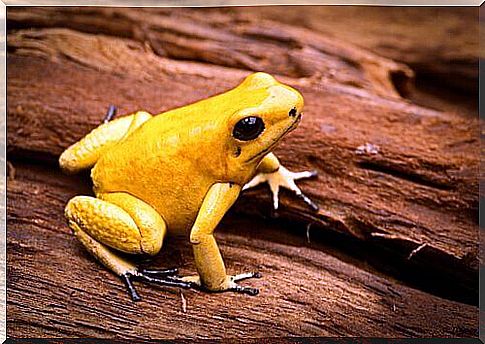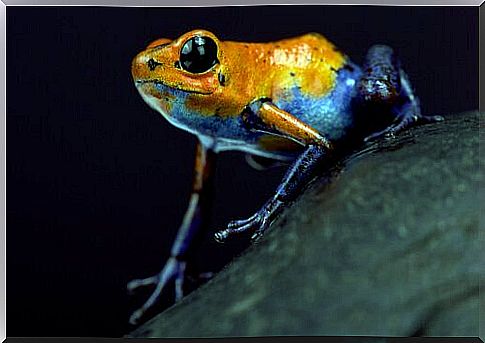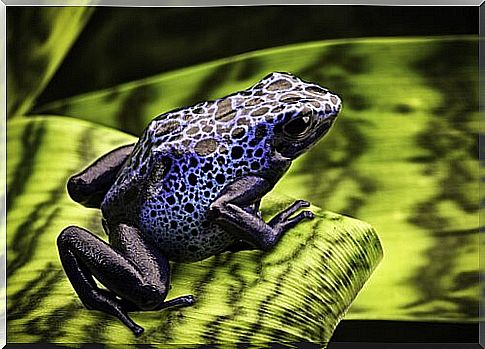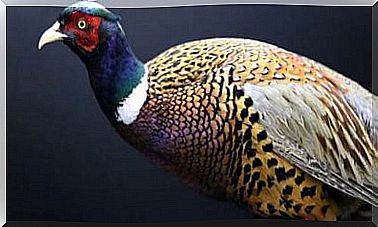Arrow Frogs, The Most Poisonous

Arrow frogs are among the most dangerous animals in the world, despite their small size and attractive appearance. In fact, these are various species of small amphibians that possess a powerful toxin in their body. If you want to know everything about arrow frogs , don’t miss the following article.
Arrow frogs: taxonomy and physical characteristics
Popularly, we call several species of Anuran amphibians of the Dendrobatidae family “arrow frogs” ( Dendrobates ) . Currently, more than 180 species of dendrobatids are known, which are usually divided into three subfamilies. All are closely related to the Aromobatidae family of amphibians .
Arrow frogs are endemic to South America and Central America and adapt to very different geographies. The largest biodiversity of these amphibians is found in Costa Rica and Panama, but they are also abundant in Colombia, Peru and Ecuador. Additionally, one species has been introduced to Hawaii, where they are considered invasive species.
Despite being very small, arrow frogs attract attention due to the intense colors of their skin. The extraordinary color schemes are an alert for predators, because they indicate their high toxicity. A defensive strategy which, in nature, is called aposematism. Currently, only two birds and a snake are known to be immune to their venom and can easily attack them.
Interestingly, the potent batraciotoxin from the skin of poisonous frogs is not synthesized by their own organism. In reality, these amphibians ingest different insects (depending on the species and their habitat ), which serve precisely for the creation of this extremely powerful neurotoxic alkaloid. In this way, the poison enters the frogs’ body and is used as a defense mechanism.
Types of arrow frogs you need to know
The large family of Dendrobatidae includes species with many peculiarities, but which share essential characteristics. Next, we will look at the 4 most representative and interesting types of arrow frogs :
Golden frog ( Phyllobates terribilis )

The golden frog is the most poisonous species in its family and also one of the deadliest animals in the world. It is estimated that only one gram of its toxin could be capable of killing 5,000 people. Therefore, it is considered the “arrow frog” par excellence. This species is endemic to the Pacific coast of Colombia.
Pygmy dendrobat ( Oophaga pumilio )

These poisonous little amphibians are well known for their polymorphism. Although popularly referred to as the “red and blue frog”, this species can exhibit a wide variety of colorations. There are one-color and two-color specimens, with or without spots and their shades may vary.
Its aposematic staining pattern is very striking, which indicates its high toxicity. This species obtains the powerful poison of its skin from the consumption of ants that synthesize batraciotoxin.
Okopipi ( Dendrobates azureus )

This species is one of the smallest of the dendrobat family, with an average size between 40 and 50 millimeters. Males are smaller and thinner than females and, in addition, they usually sing when they reach adulthood. Its habitat naturally extends from the southern Suriname until well into the Brazilian Amazon.
Different shades of blue can appear on its body, from lighter shades to dark purple hues. Each specimen usually features black spots of different designs and sizes.
Granulated frog ( Oophaga granulifera )

This arrow frog is not as famous as the previous ones, but it is interesting to mention it, since the liveliness of its colors is inversely proportional to the power of the poison. That is to say, in these amphibians, the less showy specimens are the most toxic and dangerous ones.
This species is usually endemic to the humid forests of the Golfo Dulce in Costa Rica. However, today it is a threatened species due to the devastation of its habitat .
Dart frogs trivia you should know
The particular popular name of these different species is due to their importance for the indigenous tribes of the American continent. In those hidden villages lies the origin of the different names assigned to these small but feared amphibians.
The native peoples took advantage of the toxins of the poisonous frogs to impregnate the tip of the arrows which they then used to fight and defend themselves. Therefore, these animals played a central role in the survival of indigenous communities.
Another curiosity is that, since the arrow frog derives its venom from the type of feeding, it can become harmless in a controlled environment. Obviously, however, breeding them in captivity is not recommended, as the optimal living conditions are guaranteed only by their natural habitat .









